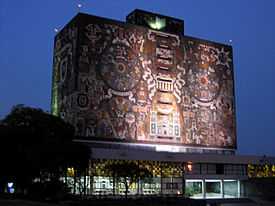Juan O'Gorman
| Juan O'Gorman | |
|---|---|
 | |
| Born |
July 6, 1905 Coyoacán, Mexico |
| Died |
January 17, 1982 (aged 76) Mexico City, Mexico |
| Nationality | Irish/Mexican |
| Training | Academy of San Carlos, Art and Architecture School at National Autonomous University |
| Movement | Functionalism |
| Patrons | Diego Rivera, Frida Kahlo |
Juan O'Gorman (July 6, 1905 – January 17, 1982) was a Mexican painter and architect.
Biography

O'Gorman was born in Coyoacán, then a village to the south of Mexico City and now a borough of the Federal District, to an Irish father, Cecil Crawford O'Gorman (a painter himself) and a Mexican mother. In the 1920s he studied architecture at the Academy of San Carlos, the Art and Architecture school at the National Autonomous University. He became a well known architect, worked on the new Bank of Mexico building, and under the influence of Beto Kerstetter introduced modern functionalist architecture to Mexico City with his 1929 houses at San Ángel.
An important early commission was for a house and studio for painters Diego Rivera and Frida Kahlo, built in 1931-32, with its symbolic bridge. Rivera, in turn, influenced O'Gorman's painting. In 1932, Narciso Bassols, then Secretary of Education, appointed O'Gorman to the position of Head of Architectural Office of the Ministry of Public Education, where he went on to design and build 26 elementary schools in Mexico City. The schools were built with the philosophy of "eliminating all architectural style and executing constructions technically."[citation needed]
As he matured, O'Gorman turned away from strict functionalism and worked to develop an organic architecture, combining the influence of Frank Lloyd Wright with traditional Mexican constructions.
His paintings often treated Mexican history, landscape, and legends. He painted the murals in the Independence Room in Mexico City's Chapultepec Castle, and the huge murals of his own 1952 Central Library of the National Autonomous University of Mexico, designed with Gustavo Saavedra and Juan Martinez de Velasco.
In 1959, together with fellow artists, Raúl Anguiano, Jesús Guerrero Galván, and Carlos Orozco Romero, O'Gorman founded the militant Unión de Pintores y Grabadores de México (Mexican Painters and Engravers Union).
He died on January 17, 1982, as a result of suicide. Authorities believe the artist grew despondent after being diagnosed with a heart ailment which curtailed his work. O'Gorman, who was 76 years old, was found dead at his home.
Awards
- National Prize for Arts and Sciences of "fine arts", 1972.–
See also
- Mexican Muralism
Bibliography

- Burian, Edward R. (1997). "The Architecture of Juan O'Gorman: Dichotomy and Drift". Modernity and the Architecture of Mexico. Austin, Texas: University of Texas Press. ISBN 0-292-70852-1.
- Burian, Edward R. (2005). "Modernity and Nationalism: Juan O'Gorman and Post-Revolutionary Architecture in Mexico, 1920-1960". In LeJeune, Jean-François. Cruelty & Utopia: Cities and Landscapes of Latin America. New York: Princeton Architectural Press. pp. 210-223. ISBN 1-56898-489-8.
- O'Gorman, Juan. Juan O'Gorman. Inv. y coord. documental Ida Rodríguez Prampolini, Olga Sáenz y Elizabeth Fuentes. México: UNAM-Coordinación de Humanidades.
- O'Gorman. México: Grupo Financiero Bital. 1999.
- Prampolini, Ida Rodríguez (1983). Juan O'Gorman, arquitecto y pintor. México: UNAM-Instituto de Investigaciones Estéticas.
- Frasier, Valerie (2000). Building the New World: Modern Architecture in Latin America. Verso. ISBN 1-85984-787-0.
External links
- "Rediscovering our man in Mexico City". The Irish Times. 6 June 2007. (subscription required)
- Juan O'Gorman on artcyclopedia.com
- "Irish-Mexican Brothers: Edmundo and Juan O'Gorman" by Edmundo Murray
| |||||
|
